
Features
Projects
Roads & Paving
Rebuilding Turcot Interchange
Quebec has begun work on bringing a critical crossroads into the 21st century.
December 2, 2013 By Carroll McCormick
Construction is underway on the replacement of Montreal’s Turcot Interchange.
Construction is underway on the replacement of Montreal’s Turcot Interchange. The busy nexus of Autoroutes 15, 20 and 720, this sprawling project will cost at least $3.7 billion dollars, with a completion date set for 2020.
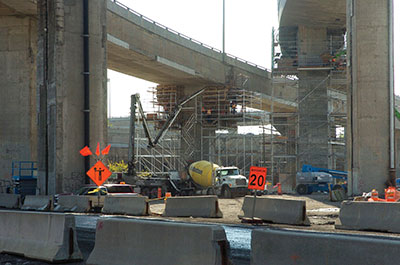
|
|
The Turcot Interchange, which opened to traffic in 1967, now carries 300,000 vehicles a day. Its serpentine heart consists of over 21 kilometres – over 128 lane kilometres – of elevated highways that soar as many as 30 metres above the ground and are stacked three high in places. Transports Quebec is in a race against time: The concrete supports under these elevated roads are deteriorating and critical structural repairs and lane closures will likely be part of the landscape until their replacements take over.
Three adjacent exchanges, Angrinon, de la Verendrye and Montreal-West, will also be replaced, as will five kilometres of the A-20 and two kilometres of the A-15. In fact, a section of the A-20 immediately west of the elevated highways will be shifted north to the foot of the Saint-Jacques escarpment, below the neighbourhood of Notre-Dame-de-Grâce. A section of CN rail line running parallel to the A-20, all that remains of the railway’s Turcot Yard, will be repositioned to the north as well.
The project goals are manifold, but key among them is reducing the amount of elevated highways. “We now have 284,000 square metres of elevated highways. An elevated highway costs 10 times more to maintain than ground roads. The project aim is to reduce by 65 per cent, in square metres, the elevated portion, to between 95,000 and 100,000 square metres,” says Alain-Marc Dubé, project bureau director, Turcot Project.
“Most of the [new roads] will be at five to six metres’ elevation but they will be on embankments, or on retaining walls, because we have very narrow rights of way,” Dubé adds.
The elevated highways represent a serious constraint for the project. Most of the road traffic on the old structures will be maintained while the new roads are built directly below or alongside them.
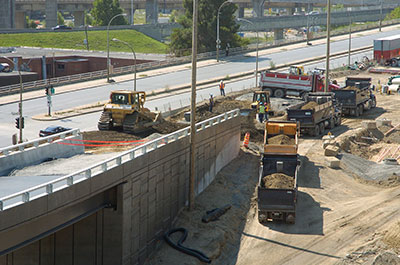 |
|
| Construction of the new Saint-Jacques exit ramp from A-720 West was completed in November 2012.
|
“Maintaining the traffic flow is a major issue. Another issue is keeping the old structures alive during the construction. If we demolish infrastructure above a road, we will close the road overnight or on the weekend. This does not take very long. We use gigantic machinery that chews on the road and reduces it to chucks very quickly, or we saw it into pieces, lower them by crane, and remove and recycle them,” Dubé explains.
In anticipation of the vast amount of material needed to build the embankments, Transports Quebec purchased the Turcot Yard in 2003 after CN moved its rail yard to a new site in 2002. It is now a hub for project construction material. “We have gathered over one million cubic metres of soil from various construction sites in Montreal for the embankments. This saved costs on those projects, and it will on ours,” Dubé says.
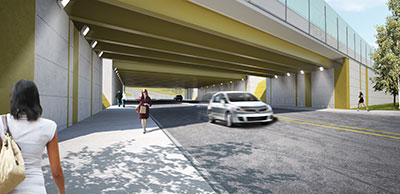
|
|
| An artist’s conception of exit Saint-Rémi.
|
Moving the A-20 and CN rail lines will make accessible the roughly 56 hectares of Turcot Yard land next to Notre-Dame Boulevard. This land will eventually revert to the city for development.
All of the demolished structures and other material that comes out of the project will be recycled. This is more than Transports Quebec usually recycles and will consequently make this Transports Quebec’s first carbon-neutral project.
The existing elevated structures are made of asphalt-surfaced concrete supported by several hundred gargantuan reinforced concrete pillars. The use of steel girders in the central part of the new construction will give the Turcot Interchange a sleeker look, according to Dubé.
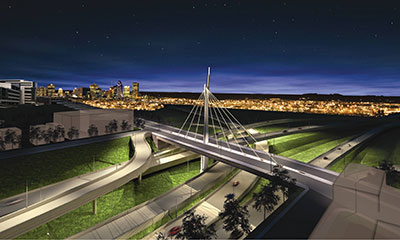 |
|
| An artist’s conception of the Saint-Jacques bridge over Autoroute 15.
|
As well as giving Montrealers a break from the austere look of poured concrete – a local construction specialty – the new roads will enjoy current standards of road construction, e.g., shoulders and longer merging lanes.
The work is divided into three phases: Phase 1, which began in 2011, is MTQ civil work, mostly on the local network, e.g., moving public service infrastructure, and moving and building local roads. The MTQ is supervising the engineering firms that design bidding documents. Firms will do surveys to make sure the work is done according to the contracts, under the supervision of MTQ engineers. Several works, such as the new Saint-Jacques, exit ramp have been completed.
Phase 2 includes demolition and the design/build work. The will take place from 2015-2020. Phase 3 is the moving of the CN rail, which CN will do itself.
One of the goals for designers is to better blend the new interchange into the urban landscape. “We are trying to integrate the project into the urban environment, for example, greening and significant architectural elements,” says Dubé. Two such architectural elements are two cable-suspended bridges – one over the Lachine Canal and the other over the A-15 at Saint-Jacques Street.
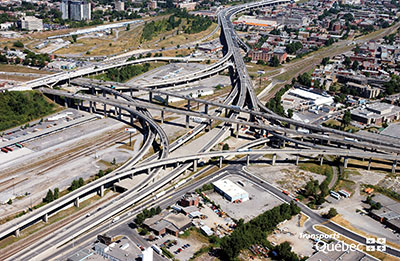
|
|
| An aerial photograph of the Turcot Interchange as it looks now.
|
The project also will integrate public transit measures. A corridor is planned for a reserved public transit lane and another corridor is planned for a possible rail link between downtown Montreal, the Trudeau Airport and the West Island. In recognition of the fact that the area being redeveloped includes residential areas, as well as 47 parks, recreational and community centres, pedestrian and bicycle paths will be built beneath the overpasses, as well in other areas.
As well, eight noise protection walls will be built and a section of an existing noise protection wall will be raised. Noise levels should be reduced by one to 15 decibels. Extensive landscaping will significantly reduce the heat island effect. Overall, says Dubé, “We have tried to integrate as much as possible to make this an exemplary project.”
Contractors involved in rebuilding Turcot
In May 2013, Infrastructure Quebec announced that three consortia will participate in the request for proposal for the design and construction of the principal infrastructure for the new Turcot Interchange:
- Groupe Futur Turcot, composed of SNC-Lavalin Construction Inc., Astaldi Canada Inc., and Zachry Corporation Intl. as primes, and EBC Inc., SNC-Lavalin Inc., Division Infrastructures, CIMA+ s.e.n.c., TY-LIN International, Janssen & Spaans Engineering Inc., Excavation René St-Pierre Inc., Division Démolition, Groupe IBI / DAA Inc., and André Major, architecte, as subcontractors
- Groupement Nouvel Échangeur Turcot, composed of Dragados Canada Inc., Groupe Aecon Québec Limitée, Pomerleau Inc., and Verreault Inc., as primes, and Dessau Inc., Roche Limitée, Groupe Conseil and Hatch Mott MacDonald Ltd. as subcontractors
- KPH Turcot, composed of Construction Kiewit Cie and Parsons Canada Ltée as primes, et Genivar Inc., Construction Kiewit Cie, Holcim (Canada) Inc., and Parsons du Canada Ltée as subcontractors
The signing of the contract for the design and construction is expected by the fall of 2014, with work to begin in 2015. AECOM reports that it, as part of a consortium, is the project/construction manager for the rebuild.
Print this page